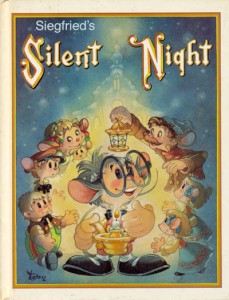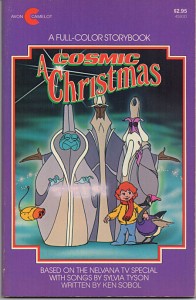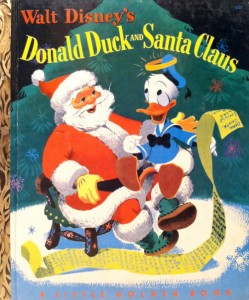Toby Bluth’s Unsold Christmas Special. Toby Bluth, one of Don Bluth’s brothers and a very talented artist, was responsible for developing a project entitled Silent Night With the Family Von Mouse, a fanciful story about the creation of the popular carol, that appeared as a hardcover children’s book in 1977. The book was an adaptation of an unsold TV special that he worked on with his brother Brad who wrote some original music for the show.
 The Von Mouse family of Austria are reminiscent of the famous Von Trapp family singers from The Sound of Music. Frau Tisa Von Mouse and her six children, Heinrich, Hansel, Heidi, Hilda, Alfred and Baby Noah, make their living as a traveling performing troupe who sing, yodel, dance and play instruments and then passing the hat for coins from their audience. Papa Von Mouse had passed away a year ago.
The Von Mouse family of Austria are reminiscent of the famous Von Trapp family singers from The Sound of Music. Frau Tisa Von Mouse and her six children, Heinrich, Hansel, Heidi, Hilda, Alfred and Baby Noah, make their living as a traveling performing troupe who sing, yodel, dance and play instruments and then passing the hat for coins from their audience. Papa Von Mouse had passed away a year ago.
After a few misadventures, they are rescued by an orphan boy named Gustav who lives in a nearby church and earns his keep by pumping the bellows to supply air for the magnificent organ. A grumpy organist Franz Gruber and his diva singing cat Brunhilda who both dislike mice are preparing for a Christmas service with kindly Father Joseph Mohr. More misadventures occur until it is all resolved with the creation of the famous Christmas carol performed by everyone.
Toby had painted every background for the proposed film as well as creating plaster models of all the characters. He tried to sell comedienne Carol Burnett on the idea of doing the project since he claimed that Mrs. Von Mouse was a caricature of her. Tim Conway would have voiced the character of Franz Gruber, the church organist.
 A revised version of the story, Siegfried’s Silent Night, was released as a book in 1983 with Brad Bluth rewriting the story in verse. The characters are similar but are all re-named with the family now being called the Vaughn mice. Alfred has become Siegfried. Henrich is Lars. Fat Hansel is Popov and so on.
A revised version of the story, Siegfried’s Silent Night, was released as a book in 1983 with Brad Bluth rewriting the story in verse. The characters are similar but are all re-named with the family now being called the Vaughn mice. Alfred has become Siegfried. Henrich is Lars. Fat Hansel is Popov and so on.
This time the family is gathering to welcome back their father who is returning for Christmas Eve from his voyage at sea as a sailor. Uriah the landlord rat bursts in to tell the family that the ship has sunk with no survivors and that if Mama Vaughn marries him, he won’t kick the family out. She refuses and he kicks them out since the father was coming with the rent money. Once again they are rescued by a young orphan boy this time named Gustel.
Once again they are taken to the church for sanctuary. Uriah shows up and tries to frame the family for destroying the organ. He is caught by young Siegfried who he kidnaps and takes to the dock to toss into the ocean. There Uriah encounters Papa Vaughn who has not drowned but quickly figures out what is going on. The rat is disposed of and the family is reunited in time for Christmas Day and the premiere at the church of the song Silent Night.
The UnMade Christmas Silly Symphony. Most animation fans are very familiar with two Disney Silly Symphonies that were made to celebrate the Christmas season: Santa’s Workshop (1932) and The Night Before Christmas (1933).
However, a few years later, Walt considered making Santa Claus Symphony (alternately known as The North Pole during development) that was proposed as a Silly Symphony short for Christmas 1937.Walt Disney in a December 1936 memo wrote, “We are planning a Silly Symphony around a Christmas theme. It will include the character of Santa Claus and perhaps show something of his workshop at the North Pole. We have several stories with this theme, but the picture will definitely have Santa Claus as the leading character. We plan this subject for a 1937 Christmas release.”
The storyline became more focused by February 1937, spotlighting a little boy who somehow was able to shrink to just a few inches and was delivered to the North Pole along with his Christmas wish list in the mail. The size of a toy, he has many comical adventures before he runs into good St. Nick and gets restored to full size and hitches a ride home with Santa on Christmas Eve.
Animation director Graham Heid sent out a memo with this story during February 1937. “The problem is to create situations that will allow for the development of good, cute comedy action growing out of the little kid’s adventures with the toys and his meeting with Santa Claus… a human reduced to the size of a toy creates an enjoyable illusion that nearly everyone with imagination has felt at one time or another.”
The memo stressed that “the toys should not be ‘humanized’ and movement should be restricted to the action of real mechanical toys. Naturally, a reasonable amount of exaggeration can be used provided it seems plausible.”
Animation artists submitted sketches of a variety of toys and Santa’s elves, some of whom look similar to the famous Seven Dwarfs, possibly in the hopes of being able to reuse some of the animation from the feature film to help out new animators. Concept artist Ferdinand Horvath did many charming inspirational sketches including a line of Dutch dolls who dance in wooden shoes creating a xylophone effect.
There is no official documentation of why the cartoon was never produced, but several factors were probably involved, including the entire Silly Symphony series starting to wind down, the need for animators who could draw this type of movement needed on the feature Pinocchio (1940) and, most likely, the fact that not enough good story ideas and gags were generated to fill a seven-minute cartoon that was holiday-oriented.

Is This Christmas, Peter? Nelvana, the Canadian animation studio, started in 1971. They produced several small projects for TVOntario and the Canadian Broadcasting Corporation. Their first half hour animated television special was A Cosmic Christmas (1977) that aired December 4, 1977 on the CBC in prime time.
 A Cosmic Christmas tells the story of three aliens who come to Earth on Christmas Eve in order to learn about a celestial phenomenon that happened two thousand years ago and are introduced to the meaning of Christmas by a young boy named Peter and his goose, Lucy.
A Cosmic Christmas tells the story of three aliens who come to Earth on Christmas Eve in order to learn about a celestial phenomenon that happened two thousand years ago and are introduced to the meaning of Christmas by a young boy named Peter and his goose, Lucy.
“People warned us not to risk it,” recounts animator and director Clive Smith. “But what else were we going to do? We weren’t pressured emotionally to worry about success or failure in those days. We just did what we loved doing.”
Nelvana lured Frank Nissen from Cinera to do layout and design for the special. Dave Thrasher, Robin Budd, Charlie Bonifacio, Vivien Ludlow, Bill Speers, Wendy Perdue and Ken Stephenson formed a tight-knit animation crew.
Filmmaker George Lucas was so taken by Nelvana’s unique style that he commissioned them to produce a ten minute animated sequence (“The Faithful Wookie”) that introduced the bounty hunter Boba Fett in the notorious CBS special Star Wars Holiday Special (November 17,1978). At the same time, Nelvana was working on its next half hour animated special The Devil and Daniel Mouse (October 5, 1978) to tie-in with Halloween.
Jamie Kellner, an executive of first run syndication at Viacom, bought A Cosmic Christmas immediately after he saw it and sold it to 185 stations in the United States. Kellner went on to become Chairman and CEO of Turner Broadcasting Systems.When the special pulled in fifteen million viewers, Viacom lobbied Nelvana to turn A Cosmic Christmas into a series with continuing adventures of Peter and the aliens. The young company turned down the offer preferring to build its catalog of high quality half hour TV specials instead.
And I wonder if even my good friend and outstanding CR columnist Greg Ehrbar has a copy of A Cosmic Christmas With Songs and Music by Sylvia Tyson – A Nelvana Story Album (NEL 7801) released in 1978 among his many treasures?
Tyson was a Canadian singing icon who performed as part of “Ian & Sylvia” and later the group “Quartette”. Not the soundtrack to the animated TV special, the record is more of a “companion volume”, with Tyson reading narration and occasionally breaking out into songs she composed like “The Way That Christmas Used to Be” and “Why Don’t They Look to the Stars?”
 Christmas in Tattertown. Animator and producer Ralph Bakshi told Variety on December 7th, 1988 that his Nickeoldeon half hour special Christmas in Tattertown (December 21, 1988) was the “first family piece” he had ever done and that all the characters created for the special were owned by Bakshi. He stated that the concept of Tattertown, a place where everything inanimate comes to life, was entirely original and has been carried around by him ever since his high school days when it was originally called “Junktown”. For those who watch closely, there is a brief cameo of Ignatz Mouse in the special.
Christmas in Tattertown. Animator and producer Ralph Bakshi told Variety on December 7th, 1988 that his Nickeoldeon half hour special Christmas in Tattertown (December 21, 1988) was the “first family piece” he had ever done and that all the characters created for the special were owned by Bakshi. He stated that the concept of Tattertown, a place where everything inanimate comes to life, was entirely original and has been carried around by him ever since his high school days when it was originally called “Junktown”. For those who watch closely, there is a brief cameo of Ignatz Mouse in the special.
The Christmas Comic Book. To the best of my knowledge, only one television half hour Christmas special was ever adapted into a comic book. A Pink Christmas, a half hour special produced by DePatie-Freleng first aired on December 7, 1978 and was very loosely inspired by the classic O. Henry short story The Cop and the Anthem. It was adapted in twenty-two pages for issue number 60 of the regular Pink Panther comic book produced by Gold Key. The cover date was January 1979 meaning that it was available roughly three months previously so would have been on the stands when the special was being shown. There is a variant cover to this issue where the Gold Key logo is replaced by the Whitman label but everything else is the same.




 Jim Korkis is an internationally respected animation historian who in recent years has devoted his attention to the many worlds of Disney. He was a columnist for a variety of animation magazines. With his former writing partner, John Cawley, he authored several animation related books including The Encyclopedia of Cartoon Superstars, How to Create Animation, Cartoon Confidential and Get Animated’s Animation Art Buyer’s Guide. He taught animation classes at the Disney Institute in Florida as well as instructing classes on acting and animation history for Disney Feature Animation: Florida.
Jim Korkis is an internationally respected animation historian who in recent years has devoted his attention to the many worlds of Disney. He was a columnist for a variety of animation magazines. With his former writing partner, John Cawley, he authored several animation related books including The Encyclopedia of Cartoon Superstars, How to Create Animation, Cartoon Confidential and Get Animated’s Animation Art Buyer’s Guide. He taught animation classes at the Disney Institute in Florida as well as instructing classes on acting and animation history for Disney Feature Animation: Florida.




















































A Cosmic Christmas is one of my favorites that I remember seeing in 1979. Sadly this special never gets any airplay here in the States nor another great animated Christmas special from Canada The Christmas Raccoons with Rich Little and Rita Coolidge.
Well YTV did stick A Cosmic Christmas up on YouTube anyway (being owned by the same group that owns Nelvana) so that’s not a total loss, the transfer quality leaves a bit to be desired I guess (kinda love to see these early specials in new HD transfers myself).
Toby Bluth is certainly a talented yet forgotten soul in animation. That “Silent Night” project sounded pretty cool had it took off.
Such a shame, we missed out on the continuing adventures of Peter and his goose pal Lucy, though at the same time, we probably wouldn’t have seen the other unique characters/world such as those in The Devil & Daniel Mouse, Romie-0 and Julie-8, Intergalactic Thanksgiving or Easter Ever.
The rest of the Nelvana specials (often titled “Nelvanamation” due to their release through Warner Home Video) used John Sebastian of The Lovin’ Spoonful for their songs/music.
At least Bakshi can claim it. Wouldn’t mind a re-release of it on Blu Ray one day if possible (I felt the “White Christmas” tune might come into question if he has to renew those rights).
Whitman was essentially the reprint label Western Publishing used for these issues (as well as for other kids books of the time), by 1980 they all but gave up on normal newsstand circulation so the Whitman name often appeared on issues that were sold in packages of 3 or so at toy stores like Toys R Us. These were the issues I was first acquainted with.
Toby did do a Christmas production which was an animated adaption of “Babes in Toyland”. I have a VHS copy of it, although I didn’t find it that memorable.
Toby did another Christmas-related special called “The Story of Santa Claus”. I see it’s up on Hulu.
In the Bakshi Unfiltered book there is a two page spread of Christmas in Tattertown characters which include Willie Whopper, Van Beuren’s Tom and Jerry, Flip the Frog, a Parrotville fireman, Bosko, the Harmon-Ising pre-Porky black pig character whose name I can’t remember, and others, underwritten with a Bakshi Productions copyright. All the characters created for the special may have been his, but I wonder how the licensing worked for the other ones, and if the copyright for some of them had lapsed when the special was made.
Nelvana’s A Cosmic Christmas may have inspired some of the Star Wars animation, but a bigger influence was probably Moebius’ Heavy Metal/Metal Hurlant comics from the 70’s, Arzach and The Airtight Garage in particular. As a side note, Stewart Copeland and Derek Holt’s incidental music for Droids deserves a legitimate release since Disney seems willing to cash in on older material. A distributor replaced it with a generic symphonic MIDI keyboard score on the Ewoks/Droids VHS compilations that came out in the 90’s, and it is worth preserving.
That mouse and Silent Night Story has been thought up by others, inspired by the true story of the organ bellows being chewed by mice and Silent night then being written for guitar. I first became familiar with it as Johann’s Gift To Christmas, written and illustrated by Canadian Len Norris. I believe that was made into a TV special with none of the charm of Norris.